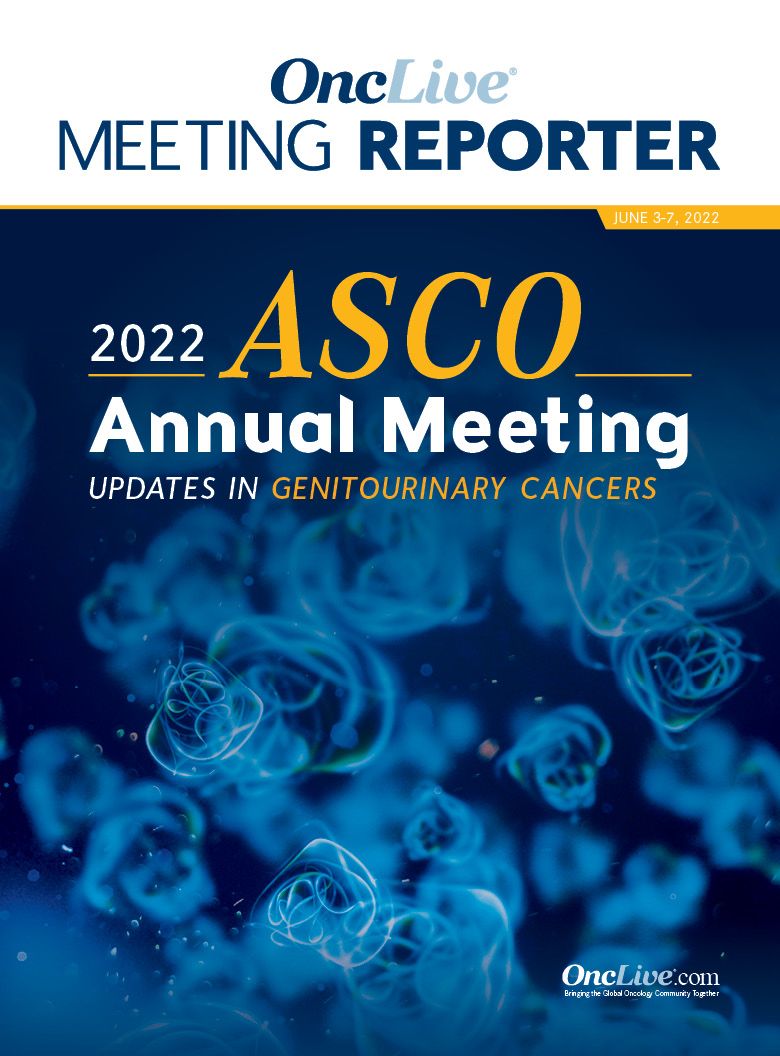Publication
Article
Supplements and Featured Publications
Batiraxcept Combinations Under Further Investigation After Promising Efficacy Signals in Clear Cell RCC
Author(s):
Batiraxcept will continue to be investigated in combination with cabozantinib, plus in combination with cabozantinib and nivolumab and as a single agent, in patients with advanced or metastatic clear cell renal cell carcinoma in a phase 2 study.
Neil J. Shah, MBBS

Batiraxcept (AVB-S6-500), a recombinant fusion protein dimer, will continue to be investigated in combination with cabozantinib (Cabometyx), plus in combination with cabozantinib and nivolumab (Opdivo) and as a single agent, in patients with advanced or metastatic clear cell renal cell carcinoma (ccRCC) in a phase 2 study (NCT04300140) after the phase 1b portion of the trial produced promising safety and efficacy results with batiraxcept/cabozantinib in pretreated patients.1
The trial overview, presented in a poster at the 2022 ASCO Annual Meeting, showed that in the phase 1b, dose-escalation portion of the study, no dose-limiting toxicities were observed with batiraxcept/cabozantinib. The study established the recommended phase 2 dose (RP2D) as 15 mg/kg of batiraxcept every 2 weeks with 60 mg of cabozantinib per day. Additionally, the maximum tolerated dose of batiraxcept was not reached, and the therapy was overall well tolerated with no severe adverse effects (AEs).
Data also showed the RP2D of batiaxcept/cabozantinib displayed clinical antitumor activity, with the majority of patients experiencing a tumor decrease relative to baseline.
“The rationale behind this combination would be that cabozantinib should be more effective within this combination, as [batiraxcept] will block the AXL pathway, followed by cabozantinib blocking the other resistance pathway,” Neil J. Shah, MBBS, a medical oncologist at Memorial Sloan Kettering Cancer Center, said in an interview with OncLive®. “That [is] the main reason why we combined these two drugs.”
Patients diagnosed with ccRCC often overexpress AXL, which is associated with resistance to VEGF and the suppression of an innate immune response. However, batiraxcept contains an extracellular region of AXL. When combined with immunoglobulin G1 heavy chain, the agent leads to inhibition of AXL in tumors.
Preclinical studies with 786-O, M62, and SN12L1 tumors demonstrated that single-agent batiraxcept achieved a significant reduction in tumor growth compared with control treatment.
“AXL is known to develop in patients with metastatic disease, and it is especially overexpressed in patients with malignancies in kidney cancer, where there has been von Hippel Lindau loss. This leads to overexpression of AXL,” Shah continued. “This pathway provides one of the resistance mechanisms, and by blocking this pathway, you will be able to control the tumor growth.”
This rationale and preclinical data led to the inception of the phase 1b/2 study, examining batiraxcept in combination with cabozantinib.
The phase 2 portion of the trial will expand the cohort of patients receiving the RP2D of batiraxcept/cabozantinib (part A). Other cohorts of the trial will investigate batiraxcept with cabozantinib plus nivolumab (part B) and single-agent batiraxcept (part C).
For all parts of the phase 2 portion of the trial, eligible patients must be at least 18 years of age with histologically confirmed metastatic ccRCC. For part A and part B, patients with prior exposure to cabozantinib will be excluded.
In part A, patients must have progressed after at least 1 prior line of therapy. Moreover, Shah noted that patients will be included even if they had previously received immunotherapy, treatment with a TKI, or any combination of treatment on the trial. In part B, patients must have untreated metastatic ccRCC. Patients in part C are required to not be amenable to curative intent therapies.
In part A, 25 patients will receive the RP2D of batiraxcept plus cabozantinib. In part B, up to 20 patients receive 15 mg/kg of batiraxcept every 2 weeks, 40 mg of cabozantinib every day, and nivolumab at 240 mg biweekly or 480 mg every 4 weeks. If no new safety signals are observed in the first 6 patients enrolled, an additional 10 will be added. If at least 6 of 10 patients achieve a response, the cohort will be expanded to 20 patients.
Part C will include 10 patients who will receive 15 mg/kg of batiraxcept every 2 weeks. If at least 1 of 10 patients respond, single-agent batiraxcept could be explored further. Overall, a total of 41 patients, including 16 patients from phase 1b and 25 patients from phase 2, have been and will continue to be evaluated on the trial.
“In the phase 1 study, the initial plan was to do a combination with cabozantinib in the second-line setting. However, we observed early and good efficacy signals,” Shah noted. “About 80% to 88% of patients had some kind of tumor shrinkage, which is unheard of in previously treated patients. Based on that, the study was amended, and the phase 2 part now includes 2 more arms.”
The primary end point of the phase 2 trial will be objective response rate per RECIST v1.1 criteria. Secondary end points include safety, duration of response, clinical benefit rate, progression-free survival, and overall survival.
“We will learn more about [safety] in our phase 2 study when we are using this agent as a monotherapy. When [batiraxcept] is [used in] combination, it is unknown what [AEs] are from [which agent], especially if they are targeting the same axis,” Shah noted. “The efficacy signal should impress you. We started noticing early responses and that a majority of patients had some kind of [tumor] shrinkage. This has potential to be practice changing in the future, and that’s why phase 2 results [will] be very important.”
The phase 2 portion of this study is currently enrolling patients, and additional data will read out at a later date.
References
- Beckermann K, Shah N, Vogelzang NJ, et al. A phase 1b/2 study of batiraxcept (AVB-S6-500) in combination with cabozantinib, cabozantinib and nivolumab, and as monotherapy in patients with advanced or metastatic clear cell renal cell carcinoma (NCT04300140). J Clin Oncol. 2022;40(suppl 16):TPS4599. doi:10.1200/JCO.2022.40.16_suppl.TPS4599
- Safety and efficacy study of AVB-S6-500 (batiraxcept) in patients with advanced or metastatic clear cell renal cell carcinoma. ClinicalTrials.gov. Updated June 16, 2022. Accessed June 24, 2022. https://clinicaltrials.gov/ct2/show/NCT04300140










